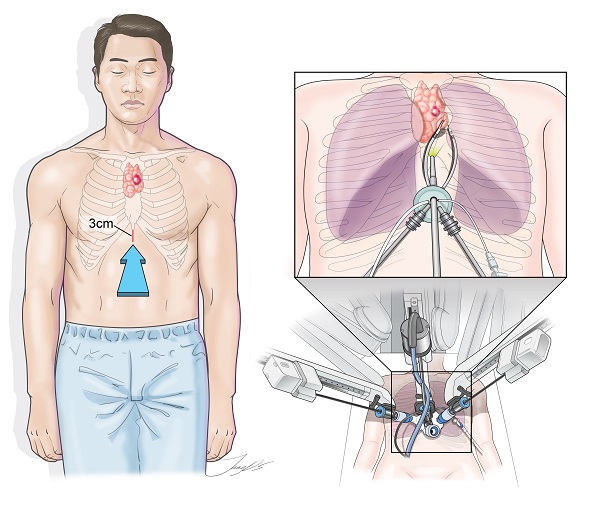Two Korean physicians have successfully operated 13 single-port and robot-assisted thymectomy cases through the upper abdominal area and reported the results for the first time in the world.
Thymectomy is usually performed by approaching the thoracic cavity through the ribs in one or both flanks. Korea University Guro Hospital Professor Kim Hyun-koo has completed thymectomy with only one port as well as through the upper abdominal area, the hospital said.

Professors Kim and Park Seong-yong at Severance Hospital published the study on the surgical case in the European Journal of Cardio-Thoracic Surgery on Feb. 15, proving its excellence, it added.
The thymus is located between the lungs in the center of the chest and is also in front of the posterior heart of the sternum. If a patient is diagnosed with thymoma, the entire thymus, including the thymoma, should be resected to lower the recurrence rate. The existing thoracic approach has had difficulty in completely excising the thymic tissue on the other side, and in some cases, the bilateral thoracic method has been used.
Surgery with the upper abdominal approach, introduced by the medical team, allows surgeons to see the thymus from the mid-center and to easily see the upper and lower thymus as well as the sections on both sides. As a result, operation with the upper abdominal approach gave a more precise view to identify the important areas than the approach through the chest. The pain at the incision site also significantly eased because the surgeons could avoid the intercostal nerve.

Besides, there were no significant differences in the thoracic duct drainage, pain, and complications after surgery compared to the existing one.
As the professors operated single-port robotic surgery, patients have fewer incision sites with a lower risk of infection after surgery. The recovery is faster, and patients more satisfied with the post-surgical appearance.
“The thesis has proved that a single-port robotic thymectomy approached from the abdomen direction was safe and technically available,” Professor Kim said. “I expect more difficult chest surgeries will be operated with a single-port and robot-assisted technique.”
Professor Park said, "There remain limits such as the movement of the instrument and securing distance in the single-port and robot-assisted thymectomy, but the problems will be solved because the robot technology continues to develop."
Meanwhile, the duo has pioneered a new field of thoracic surgery by presenting the world's first robotic single-port thoracic surgery case to the U.S. medical journal, “Annals of thoracic surgery.”

